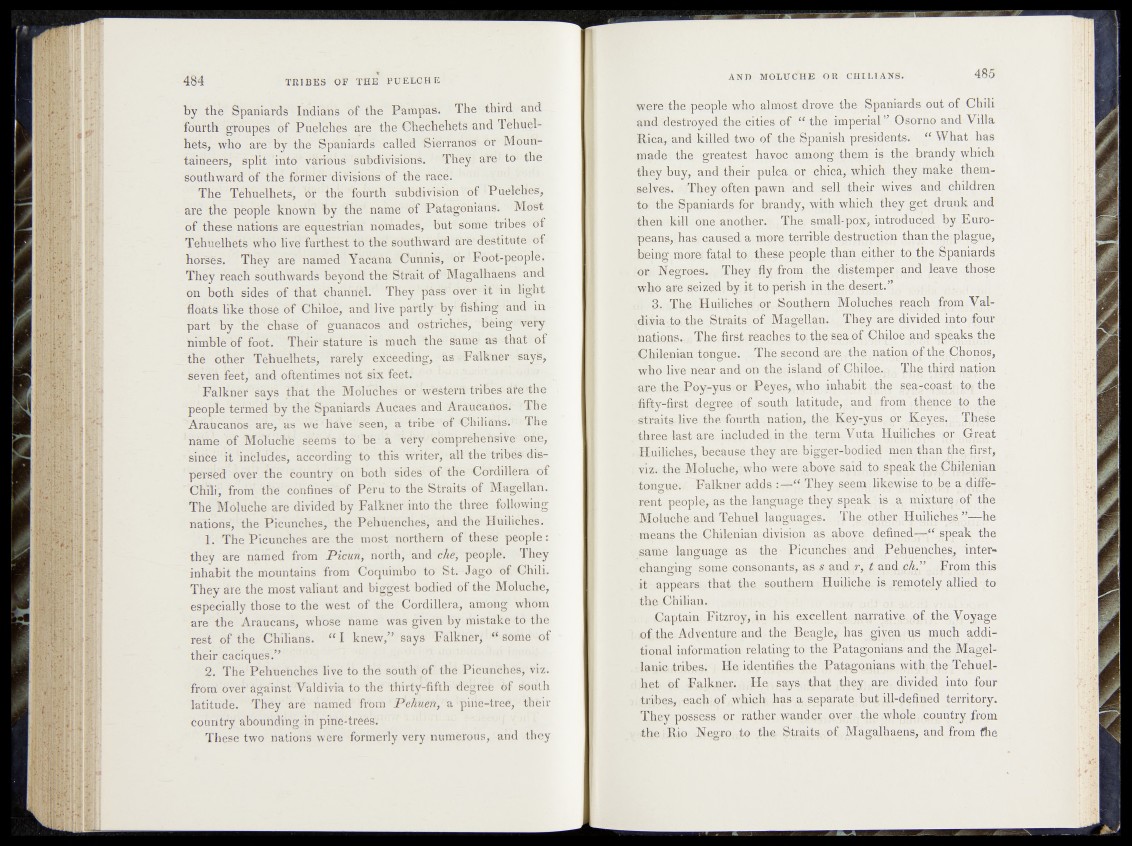
by the Spaniards Indians of the Pampas. The;;third and
fourth groupés of Puelchès are the Chechehets and Tëhuel-
hèts, who are by the Spaniards called Si'drraiiös gt Mouiï-
tairieers/ split Info* ■s^l4i^,iubdivîëîbïiS. ' They: aW to* the
Sbuthwafd of thé former fKVïsfoiiö,'eïf thé racé.'
The Tehuelhets', bf the 'foûrth subdivision of 'PueleHes,
are the people knovvn by the' name of PatagohifiUsu MoUt
of these nations are equestrian nomades, bUtv:#öme tribe#’öf
Tehuelhets who live farthest to the southward are- destitute of•
horses. They are naméd Yacana Curinis, ’or 'Fóot-péoplê.
They reach southwards beyond thé Strait of Magalhàens and
on both sides of that channel. They * pàs#,dvfer,:iit in light
floats like those of Chiloe, and live paftly by‘ fishing 'and in
part bÿ thé ’ cha#e of guahâeo# and osfriéhès,
nimble of foot. Their stature is much the srame as that of
the other Tehuelhets; rarely èxcêedlfig, ''às - PalfeneF‘;'Sàÿ-fe,
seven feet, and oftentimes1 not’ six feet.1 '
Falkner says that thé Móluchës ‘t>r wéétêrli tribe# ufo>the
people termed by the Spaniards AueUes'ahd AraJUfeaU^sh'/Tile
Amucanó# aÿe,/as wé have seen, a tribe rif -ChiliânsdL The
' name of MoTudhb .shems to be a Véfy ' cbmprëhéfrsi Ve-
| since it includes, according to this writer, alt the ‘tVibés!idte-
persèd oyer the country oh both sides1 vof the Cordillera >of
Chili; from thé' confines 'of Peru to the Straits of Magellan.
Thé Móluche are divided by Falkliér'ihtô --tliie
nations, the Picunches, the Pehuenehes, and the’ IJuiliches.
1. The Picunches are the most northern of'thesd people :
they are named from JPicun, north, and chê', people. They
inhabit the mountains from Coquinibo to‘ Sb. dlago ‘óf:Chili.
They ate the most valiant and biggest bodied of the Moluche,
especially those to the west of the Cordillera, among whom
are the Araucans, whose name was given by mistake tó the
rest of the Chilians. “ I knew/’ says Falkner/'^some of
their caciques.”
2. The Pehuenehes live to the south of the Picunches, viz.
from over1 against 'Valdivia to the thirty-fifth degree of south
latitude. ’ They are named from Pehuen, a pine-tree, their
country abounding, in pine-tréés.
These two nations were formerly very numerous, and they
were the people who almost,drove t,he Spaniards out of Chili
and destroyed the citie#q^ju the imperial'”, Osorno and Villa
Eipaj, and killed two of the Spanish presents.;,*,,/* What has
made the, greatest havoc among thepa is the .brgndy which
they.-buy, and, their pulca. or^chipa, .^yhjchi they^tna-ke themselves,
- They often pawn'nnd|||ief||!s their swiyqs^.and. children
to, ?the Spaniards-for brapdy^ with w.hich^ t h ^ d r u n k and
»then kill qne anptheiuf (The. sj^alhppx, iptrodiij^ed.by Eurp-
jpegns,' has, caused a more terriblenl^st^uption t^ap the plague,
being mores fatghfo these pepplq thpn pijhepdPdrip Spaniards
■or Negrpqs. , They ,fly from t h e * . $ p d jripye those
rwhi# afie$ei?#skby itrtqpe?ish ^tl^i^e^e^t.’’^
ii p | The Huiliches’jOr Squthqrn ■M^che^' rgaqh from . V^l"
divia-to, the „Straits of Magellan, They undivided ipto^fqur
nati.QUSi, The.fir^reaplig^Ofthe^eqjP^Qhjloepn^ ^pe^k^jthe1
Chi-lenian tpngug; .The sqcqnd^arp^the fn,at|o.p, oft^g^ho^p^,
who live hear and on the island pf Gh^,e^( Tjip tfybd ^ tiq n
#je>the;Phyryus?or Pqyes*(who inhabit tjthe |eagc^^^iJe| the 1
sfoly-fhst degree jpf,.south l a t i tq ^ .and from", tte p ^ |to ; the
.Strait^ live the fourth, , pat ion,,, the, K e y ^ s ^ r
ihsee last are included, in theater pi Yuta H,uiliph^s fir ramH
Hailiches,,because they are, rp^ptlj^p
viz. the Mduche, who were above, saijdfi|p^pgak thq^^gpip.n
dpnguei/-Falkqer adds They ^e.pm.,likewise
yent. people;?## the language they speak;
Molhchu and Tehuel languages. ,The:jpf^e^)jl|u jh |n ^ 1”f^rhe
mean# the-CWenian division as (a b c ^ ^ ^ j^ j r f d s p p a k the'
same language as the PicuqpJi^skaP^
chansfine: same eon#pnants,,as-s this
it appears that the sputhern Huiliche. is ^rpmotely ajlj^qto
the Chilian»
, Captain Fitzrqy, in Jbis, e^cpl|enk,^|E^ra|i,yje ^ ^ )(|h eH^qyage
, iof1the.Adyenth|,e and-the Beagje^ has jp^qnyijs ^ p q h additional
information relating to the Patagonians* and (t;he .IV^agpl-
lanfoitribes, , He
iihet #f Faikbht»; !H% j^aySvf^ ^ f f^ fy ;(a^e, ^iyidud .into four
; trijbes^reaehspf/,which, has s^pqyr^tp^ 'feretory.
They possess or rather wan4^-iPypjt f-,tj^pTy,-hj§|plftqoiuqtjydrrom
thfe iFfo jthe and, from the